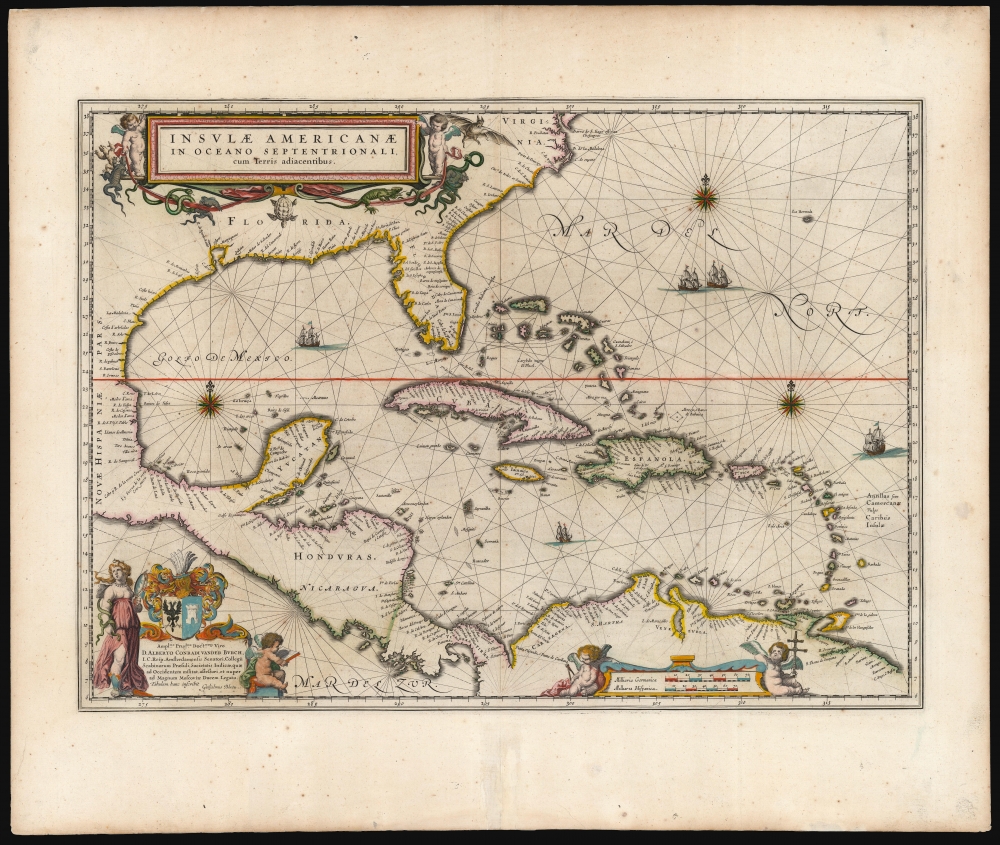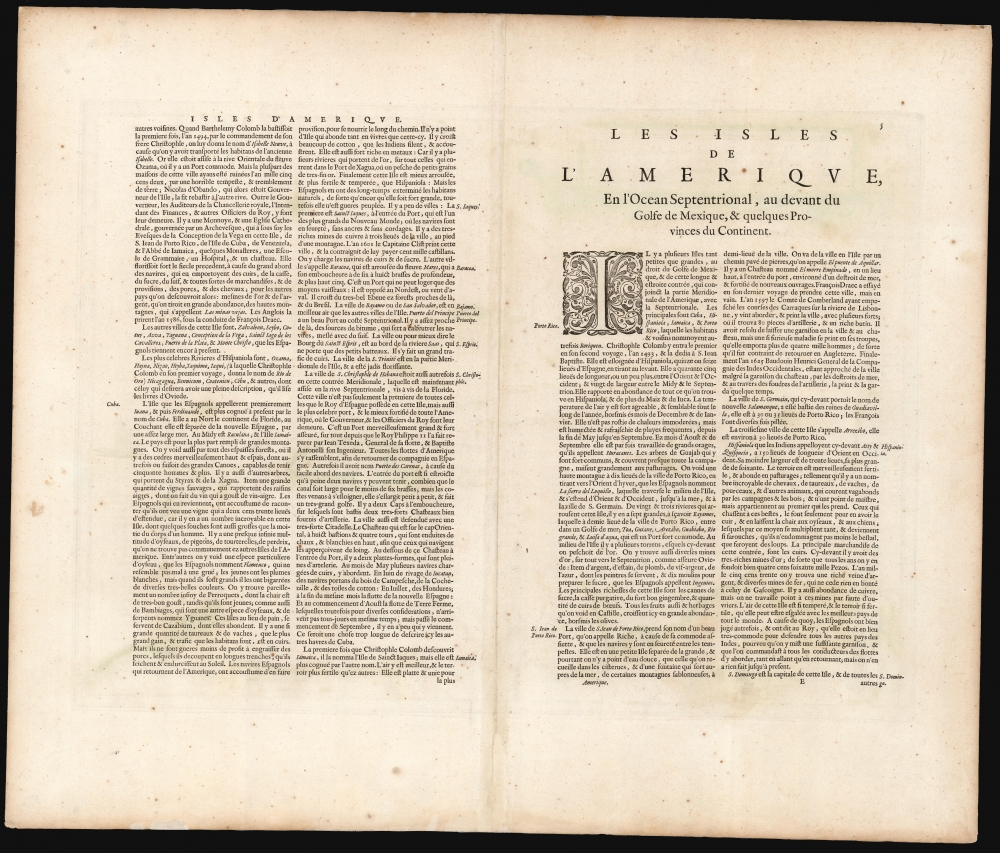This item has been sold, but you can get on the Waitlist to be notified if another example becomes available, or purchase a digital scan.
1643 Blaeu Map of the Caribbean Sea and the Gulf Coast
WestIndies-blaeu-1634-4
Title
1634 (undated) 15 x 20.75 in (38.1 x 52.705 cm) 1 : 10200000
Description
A Chartlike Map
While Blaeu's atlases were not intended for use at sea, the sources for this map were nautical charts intended for Dutch West India Company navigators. The geographical detail of the chart reflects its sources in that the interiors of its landmasses are empty: nautical charts were not concerned with matter beyond the coastlines they depicted. The decorative features of the map also emphasize the map's chartiness: the water areas are marked out with rhumb lines, three fine compass roses, and five well-engraved sailing ships.Richly Decorative
In addition to its nautical features, the map is embellished with three cartouches. In the lower right, the scale cartouche is flanked with putti playing with navigational tools; in the upper left, the title cartouche's two putti are accompanied by snakes, a turtle, a bat, and an alarming number of iguanas. The dedicatory cartouche to Albert Conrad van der Burch (Dutch senator, soldier, and diplomat) is surmounted by the dedicatee's arms. To its right, a putto sits reading. To the left is an allegorical female representation of the virtue of Prudence, marked by snakes and a mirror, stands. Since her face is that of a young woman, the aspect of Prudence invoked here is foresight and the wise pursuit of long-term goals. Whether this is an actual element of the dedicatee's personality, one which the author wished to instill in him, or one with which Blaeu is flattering his dedicatee is lost to posterity.Publication History and Census
This map was engraved by Blaeu for first inclusion in the 1634 German edition of the Blaeu Novus Atlas. The present example corresponds to the 1643 French text edition noted in Van der Krogt. This map remained in editions of the Novus Atlas and the Atlas Maior throughout the Blaeu family's publication history; consequently, separate examples of this map are well represented in institutional collections, and the map appears on the market from time to time in varied condition. Examples of this quality are nonetheless, which are increasingly scarce on the market.CartographerS
Willem Janszoon Blaeu (1571 - October 18, 1638), also known as Guillaume Blaeu and Guiljelmus Janssonius Caesius, was a Dutch cartographer, globemaker, and astronomer active in Amsterdam during the late 16th and early 17th centuries. Blaeu was born 'Willem Janszoon' in Alkmaar, North Holland to a prosperous herring packing and trading family of Dutch Reformist faith. As a young man, he was sent to Amsterdam to apprentice in the family business, but he found the herring trade dull and instead worked for his cousin 'Hooft' as a carpenter and clerk. In 1595, he traveled to the small Swedish island of Hven to study astronomy under the Danish Enlightenment polymath Tycho Brahe. For six months he studied astronomy, cartography, instrument making, globe making, and geodesy. He returned to Alkmaar in 1596 to marry and for the birth of his first son, Johannes (Joan) Blaeu (1596 – 1673). Shortly thereafter, in 1598 or 1599, he relocated his family to Amsterdam where he founded the a firm as globe and instrument makers. Many of his earliest imprints, from roughly form 1599 - 1633, bear the imprint 'Guiljelmus Janssonius Caesius' or simply 'G: Jansonius'. In 1613, Johannes Janssonius, also a mapmaker, married Elizabeth Hondius, the daughter of Willem's primary competitor Jodocus Hondius the Elder, and moved to the same neighborhood. This led to considerable confusion and may have spurred Willam Janszoon to adopt the 'Blaeu' patronym. All maps after 1633 bear the Guiljelmus Blaeu imprint. Around this time, he also began issuing separate issue nautical charts and wall maps – which as we see from Vermeer's paintings were popular with Dutch merchants as decorative items – and invented the Dutch Printing Press. As a non-Calvinist Blaeu was a persona non grata to the ruling elite and so he partnered with Hessel Gerritsz to develop his business. In 1619, Blaeu arranged for Gerritsz to be appointed official cartographer to the VOC, an extremely lucrative position that that, in the slightly more liberal environment of the 1630s, he managed to see passed to his eldest son, Johannes. In 1633, he was also appointed official cartographer of the Dutch Republic. Blaeu's most significant work is his 1635 publication of the Theatrum orbis terrarum, sive, Atlas Novus, one of the greatest atlases of all time. He died three years later, in 1638, passing the Blaeu firm on to his two sons, Cornelius (1616 - 1648) and Johannes Blaeu (September 23, 1596 - December 21, 1673). Under his sons, the firm continued to prosper until the 1672 Great Fire of Amsterdam destroyed their offices and most of their printing plates. Willem's most enduring legacy was most likely the VOC contract, which ultimately passed to Johannes' son, Johannes II, who held the position until 1617. As a hobbyist astronomer, Blaeu discovered the star now known as P. Cygni. More by this mapmaker...
Hessel Gerritsz (1581 – September 4, 1632) was a Dutch engraver, cartographer, and publisher active in Amsterdam during the late 16th and early 17th centuries, among the most preeminent Dutch geographers of the 17th century. He was born in Assum, a town in northern Holland in 1581. As a young man he relocated to Alkmaar to accept an apprenticeship with Willem Jansz Blaeu (1571-1638). He followed Blaeu to Amsterdam shortly afterwards. By 1610 he has his own press, but remained close to Blaeu, who published many of his maps. In October of 1617 he was appointed the first official cartographer of the Vereenigde Oost-Indische Compagnie (Dutch East Indian Company) or VOC. This strategic position offered him unprecedented access to the most advanced and far-reaching cartographic data of the Dutch Golden Age. Unlike many cartographers of his period, Gerritsz was more than a simple scholar and showed a true fascination with the world and eagerness to learn more of the world he was mapping in a practical manner. In 1628 he joined a voyage to the New World which resulted in the production of his seminal maps, published by Joannes de Laet in his 1630 Beschrijvinghe van West-Indien; these would be aggressively copied by both the Blaeu and Hondius houses, and long represented the standard followed in the mapping of the new world. Among his other prominent works are a world map of 1612, a 1613 map of Russia by the brilliant Russian prince Fyodor II Borisovich Godunov (1589 – 1605), a 1618 map of the pacific that includes the first mapping of Australia, and an influential 1630 map of Florida. Gerritsz died in 1632. His position with the VOC, along with many of his printing plates, were taken over by Willem Janszoon Blaeu. Learn More...




